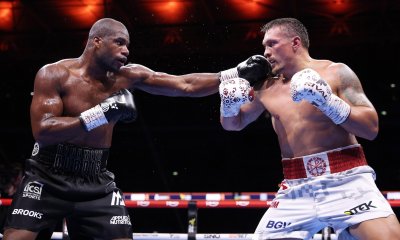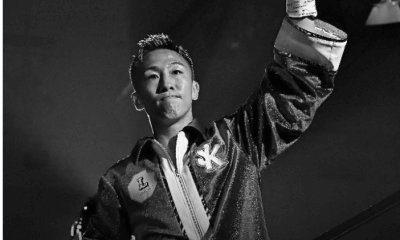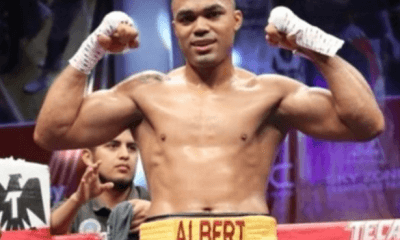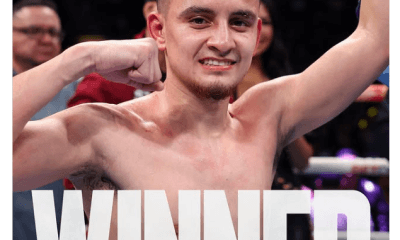Canada and USA
Memories of Hagler-Leonard, 30 Years Later
LOOKING BACK AT HAGLER-LEONARD — It’s funny, some of the little things you remember about a major boxing event that took place 30 years ago. Oh, sure, the big stuff was really big when long-reigning middleweight champion Marvelous Marvin Hagler and Sugar Ray Leonard squared off the night of April 6, 1987, in the outdoor stadium at Caesars Palace: A sellout crowd of 15,366, with ticket demand such that the place could have been filled three times over had that many seats been available! Some 1,100 credentialed media members, 300 of whom were obliged to watch the bout on a big screen in the nearby Caesars Pavilion! Celebrities galore milling about in the hotel and casino! A huge (well, it was at the time) financial pie of $33 million to be shared by the main-event participants! And enough plot twists — before, during and after the first punch was thrown – to keep any industrious journalist hip-deep in interesting copy for weeks, months and even years on end!
When TSS editor Arne K. Lang — who also was in the house when Leonard shocked the world by winning a 12-round split decision that is still the root of considerable debate — asked me to author a story on my memories of the week that was, it was like a return to Wonderland. But where to begin? By cataloguing some of the more pertinent details of my very first working assignment to the Vegas Strip? Nah, too easy. Everybody knows most of those, anyway. So I choose to start with a more personal recollection, of an industrial-sized refrigerator in the press tent that offered daily reminders that my presence was not that of just another milling face in the crowd.
Pineapple juice and chocolate milk.
Caesars Palace’s crackerjack publicist at the time, Debbie Munch, is now an executive with Caesars Entertainment who will be inducted into the Nevada Boxing Hall of Fame on Aug. 12. Upon introducing myself to her—it probably didn’t hurt that I was representing a major metropolitan daily, the Philadelphia Daily News — she inquired as to which item I wished to be stocked in that refrigerator. “Um, pineapple juice?” I responded, not quite sure if I was being pranked with a trick question. Another reporter, Chris Thorne of the Newark Star-Ledger, then opined that he was rather fond of chocolate milk.
An hour or so later, small cans of pineapple juice and half-pints of chocolate milk were being chilled for Chris’ and my presumed benefit. And as soon as the supply of those beverages was depleted, the refrigerator was quickly replenished with more, along with a standard assortment of soft drinks. Those cans of pineapple juice made me feel as if I were Julius Caesar himself, just returned to Rome from his triumphs in the Gallic War. For years afterward, whenever I returned to Caesars Palace, that press-tent refrigerator contained cans of pineapple juice. I didn’t even have to ask.
It had been nearly two decades since I had spoken to Debbie, which is understandable since it had been two decades since the last fight in the outdoor stadium, which periodically arose on the site of Caesars Palace’s tennis courts, had been staged there. In case you’re interested, that going-away present to fight fans was Oscar De La Hoya’s dethronement of WBC super lightweight champion Julio Cesar Chavez, via fourth-round stoppage, on June 7, 1996. Not long after that, construction of a new hotel tower consumed the space once reserved for the tennis courts and big-time boxing, the cranes and pile-drivers marking the end of an era. Where Caesars Palace once was Vegas’ main magnet for superfights – Larry Holmes appeared there a record 14 times, followed by Thomas Hearns (11), Leonard and Roberto Duran (9 apiece), Evander Holyfield (7), Marvin Hagler (5) and Chavez, De La Hoya and Alexis Arguello (4 apiece) – much of the city’s ring action has shifted to the MGM Grand, Mandalay Bay, Thomas & Mack Center and, most recently, the gleaming, new T-Mobile Arena.
Imagine my surprise when I got Debbie on the phone, asked what she remembered about about Caesars Palace’s glory days, specifically Hagler-Leonard, and she said, “With you, I’d probably say pineapple juice and chocolate milk.”
Such total recall of seemingly meaningless minutia, even if I wasn’t the chocolate-milk requester. No wonder the lady is an impending Nevada Boxing Hall of Famer.
But if Caesars Palace, which opened with 680 rooms on Aug. 5, 1966 (it now has 4,610) was the site of such classic bouts as Leonard-Hearns I, Hagler-Hearns, Holmes-Norton and Bowe-Holyfield II, a case can be made for Hagler-Leonard, in some ways, being the most significant pugilistic showdown in the site’s rich history. It was, arguably, the most-anticipated fight since the first entry in the three-bout passion play involving Muhammad Ali and Joe Frazier on March 8, 1971, in Madison Square Garden.
“There wasn’t the sheer energy of Hagler-Hearns or the back-and-forth momentum changes of Leonard-Hearns, but I think everyone came away saying, `We saw a very good fight,’” Rich Rose, who then worked with Hagler’s promoter, Top Rank founder Bob Arum, and later went on to serve as head of Caesars Palace’s sports division, said of Hagler-Leonard. “And with the possible exception of Mike Tyson, Marvin and Ray were the dominant fighters of the 1980s, at a time when they were in their early 30s, still reasonably young. Yes, Ray had been off a long time (he hadn’t fought in three years, and just once in five years) and, yes, Marvin probably had lost a step and a half from what he had been. But they were still tremendously well-known, bigger-then-life figures. Tommy and Roberto were in the mix as well, but Marvin and Ray, no disrespect to the other two, were leading the pack.”
The long, winding path that eventually culminated in Hagler-Leonard could be traced back to at least 1982, but the inevitability of their pairing probably began much earlier than that. Hagler, who had been a U.S. national amateur champion, turned pro for peanuts in 1973 (he reportedly received $40 for his two-round knockout of Terry Ryan on March 18 of that year, in the Brockton [Mass.] High School Gymnasium) because he couldn’t afford to hang around in the hope of making the 1976 American Olympic boxing team that competed in Montreal.
The charismatic Leonard, of course, went to Montreal, won a gold medal and was soon being groomed for stardom in the punch-for-pay ranks. He pulled $40,000 for his pro debut, a six-round unanimous decision over Luis Vega in the Baltimore Civic Center on Feb. 5, 1977, which was televised via ABC Wide World of Sports.
Such purse disparities can breed envy among those who must scratch and claw their way up through the ranks, and it wasn’t long before Hagler found himself among those jealous of all the perks that flowed so freely to Sugar Ray.
“I didn’t resent Leonard when we were both coming up,” Hagler said of the time before his feelings toward his future arch-rival began to harden. “As a matter of fact, I kind of liked him. I’d been following him since the Olympics, like everybody else.”
But Hagler, not as naturally outgoing as Leonard, figured his talent was no worse than a match for that possessed by boxing’s golden child, and the fire in his belly burned hotter when Leonard was paid $1 million for his first shot at a world title, in which he dethroned WBC welterweight ruler Wilfred Benitez on a 15th-round TKO on Nov. 30, 1979. Appearing on the undercard that night at Caesars Palace, and making his first bid to become a world champion, Hagler not only had to settle for a low-ball $40,000 purse, but the crushing realization that a bloodied and battered Vito Autuofermo had retained his WBC and WBA middleweight belts on a split draw in a fight almost everyone else believed the challenger had won handily.
Maybe that’s when Hagler resolved that he and Leonard would settle the question as to who was the better man where it counted, in the ring. But although each continued to add layers of success onto their legendary careers, it must have seemed as if fate was conspiring to thwart an epic clash of the titans. Leonard insisted he was comfortable at welterweight, and at 147 pounds was simply too light to move up to test the middleweight waters against the fearsome Hagler. Not only that, but he suffered a detached retina – often a career-killer in those days – when he was in advertently poked in the left eye by the gloved thumb of a sparring partner in the spring of 1982. The eye immediately reddened and Leonard’s vision became blurred. The blurring cleared up after a short time, but the spots in his line of vision did not.
After the detached retina was diagnosed, Dr. Ron Michels operated on Leonard’s eye to repair the damage. Although advances in laser technology later made the reattachment of retinas a common surgical procedure, such was not the case 35 years ago.
Although Michels assured him that his left eye was fully healed, Leonard, who had impulsively retired and unretired twice, wrestled with the fear that continuing to fight might leave him sightless. That, and the urging of his first wife, Juanita, edged him toward a momentous decision.
Ever the showman, Leonard rented the Baltimore Civic Center on Nov. 9, 1982, for a black-tie gala attended by 10,000 fans and special guests. Among those on hand was Hagler, who wore a tuxedo for what he presumed would be the announcement that the fight everyone wanted to see was going to be made.
In a ring that had been set up for the occasion, Leonard looked at Hagler and addressed the crowd. “A fight with this great man, with this great champion, would be one of the greatest fights in history,” Leonard said. “Unfortunately, it’ll never happen.”
There was a gasp, followed by stunned silence. Hagler felt, with ample justification, he had been sandbagged. This is not what he came to hear. But even as he was saying the words, Leonard had doubts about their validity for the long term.
“Yeah, I said, `This is it, I’m done,’ but I’m not sure I believed it,” he would later admit. “I think I realized I might change my mind later, but I felt pressured to do the logical thing, which was to retire.
“I was, what, 26 years old then? I was a young guy still at the top of my game. But I guess I just wanted to put an end to the questions. My mind told me what to say, but in my heart my competitive fire was still burning.”
The flame might have been set on low, but it never went out. Leonard accepted a position as a boxing analyst for HBO, which allowed him to be at ringside for a number of Hagler’s title defenses.
“Marvin became my friend,” Leonard said. “We’d talk. There was no barrier between us because I was out of it; he didn’t consider me a threat to him. So he told me things that I mentally stored away.
“When he came for the grand opening of a restaurant in Bethesda, Md., I had a little piece of, we were drinking champagne. He said, `Yeah, man, I’m not motivated. I’m starting to get cut easily.’ It didn’t seem like he was into boxing that much anymore. I don’t know how significant that conversation was, but it was one of a lot of factors in my decision to come back.”
Perhaps the most crucial of those factors was Hagler’s performance in a tougher-than-expected, 11th-round knockout of John “The Beast” Mugabi on March 10, 1986.
“It was a cold night in Vegas,” Leonard recalled. “I saw Mugabi outjabbing and outboxing Hagler. It was a bad, bad night for Marvin, even though he won. It took a toll on him physically. It also seemed to me that he wasn’t as focused.”
Leonard – who had had only one bout since February 1982, a ninth-round stoppage of Philadelphia journeyman Kevin Howard on May 11, 1984, in which Leonard was floored himself – made another announcement. He was back, and he was going after Hagler.
“When I said I was coming out of retirement, the reporters wanted to know who my tune-up fight was going to be against,” Leonard said. “I said, `No tune-up. I’m going straight to Marvin.’ Even my brother Roger thought I had lost it. There was no one, besides my father, who thought I had a prayer.
“Well, there was my father and Mike Trainer (Leonard’s longtime attorney/adviser). I talked to Mike after I came back from watching Hagler-Mugabi. I said, `Michael, me and Hagler, who wins?’ He looked me right in the eye and said, `Ray Leonard can’t beat Hagler. But Sugar Ray Leonard can.”
The Vegas oddsmakers didn’t believe just-plain Ray or his sugary alter ego could be competitive against Hagler. What kind of man can fight just once in five years, looks terrible in that single ring appearance, and tries to jump up two weight classes to take on one of the most dominant middleweight champions of all time? Hagler hadn’t lost in 11 years, a stretch during which he had gone 34-0-1 (that disputed draw with Antuofermo) with 32 KOs. Hagler was an opening-line 20-to-1 favorite.
But there was more to what would eventually transpire in the ring than met the eye, as is often the case. Since returning to the gym, Leonard had secretly engaged in four bouts against top-20-type opponents, against whom he had gone 4-0 with two KOs. He would not be going against the very confident – perhaps overconfident – Hagler with that thick a coating of ring rust. There was also some question as to just how much mileage Marvelous Marvin had on his ring odometer; although his official age was just shy of 33, his personal photographer, Angie Carlino, allowed that he had seen a birth certificate which listed Hagler’s birth year as 1952, which would made him closer to 35.
“He was closer to the end than people realized,” Carlino later said of his friend and employer.
But it was the fight before the fight where Leonard and Trainer laid the real groundwork for what would take place inside the ropes. Already far richer than Hagler, Leonard gladly agreed to accept less money – a base purse of $11 million to $12 million for the champion, with the lion’s share of the closed-circuit money (which turned out to be another $10 million) also going to Hagler. The tradeoff is that Leonard and Trainer got the non-financial concessions they sought, which included a larger ring (20 feet instead of the 15-foot bandbox preferred by Hagler and his handlers, Goody and Pat Petronelli), 12 rounds instead of 15 and larger gloves.
Why had Hagler agreed to certain contract stipulations that figured to benefit Leonard on fight night? Maybe because he believed that, by getting more money than boxing’s popular ATM machine, he was finally being accorded the kind of respect that only shows up on a bank ledger. More likely, he was adamant in his belief that whatever advantages Leonard and Trainer had procured at the negotiation table would be erased the first time Sugar Ray tasted his punching power. So what if the ring was larger? Like Joe Louis once said, you can run, but you can’t hide.
“I believe there was animosity on Marvin’s end, even more so than usual,” said Rose. “When he was preparing for a fight, Marvin always viewed his opponent as the bad guy and worked up this venom against him. But with Ray, I think he especially resented that he had to come up the hard way and Ray, as the Olympic darling, had it so much easier. They weren’t alike in most ways. The main common denominator they shared was prodigious talent.”
Although a Las Vegas newspaper poll had 60 of 67 media members picking Hagler to win, Leonard’s popularity with the public was such that he was bet down to just a 5-2 underdog by the time the opening bell rang. It was a virtual replay of what had happened on Oct. 2, 1980, at Caesars Palace when Muhammad Ali was such a sentimental favorite over a prime heavyweight champion Larry Holmes that he somehow went off as the wagering choice. But sentimentality counts for little in the prize ring, and Ali’s trainer, Angelo Dundee, ran up the white flag in the 10th round with his legendary fighter absorbing a fearful beatdown.
Despite fears that Leonard would suffer the same disastrous consequences against Hagler, the sporting world took notice to an extent that few, if any, boxing matches do now. The Washington Post and Boston Globe each dispatched seven reporters to cover the fight, and the two Las Vegas papers’ carpet-bombed it with a combined 17 scribes who must have found it a daunting challenge to come up with new material throughout the week. My paper made do with four on-site reporters, but augmented its extensive daily coverage with a 16-page pullout section the day before.
All that remained was for the fight to live up to the runaway hype, and to a large degree it did. Leonard proved to be sturdier than the flimsy shack so many had predicted would be blown away by Hagler’s hurricane-force winds. The parallel story lines that quickly developed were Hagler’s somewhat perplexing decision to switch from his standard southpaw stance to orthodox, and Leonard’s intelligent and effective strategy of stealing rounds with 30-second flurries at the end of certain rounds.
The decision for Leonard – judges Jo Jo Guerra and Dave Moretti scored it 118-110 and 115-113, respectively, for the new middleweight champion, while Lou Filippo had Hagler ahead, 115-113 – is especially curious in light of the fact that the originally appointed British judge, Harry Gibbs, had been rejected by the Hagler camp, ostensibly because of the way Marvin had been treated in England for his title-winning third-round knockout of Alan Minter on Sept. 27, 1980, in London’s Wembley Stadium. Inebriated Minter supporters had pelted the ring with bottles and folding chairs in response to Hagler’s thrashing of the home-country hero. Apparently still miffed by that fusillade, Hagler and the Petronellis demanded Gibbs be replaced with “a Mexican judge,” Guerra, who submitted a scorecard that had Leonard winning 10 of 12 rounds. As it turned out, Gibbs, who had flown home and watched the fight on television, said he would have scored it for Hagler.
Opinions always will vary, and for everyone who insists the judges made the right call – renowned trainer Gil Clancy, a color commentator for the U.S. closed-circuit telecast, said Leonard’s effort was “the greatest performance I’ve ever seen by any boxer” – there is someone who is just as sure that Hagler was robbed. Certainly Hagler felt that Leonard’s hit-and-run tactics were somewhat less than valiant.
“He fought like a girl,” sneered Hagler, who during the bout tried to goad Leonard into engaging at close quarters by saying, “Slow down, you little bitch. Fight me like a man.”
As everyone knows, there was no rematch. Hagler retired, moved to Italy and became an actor. Leonard was 2-2-1 in his five bouts after Hagler, retiring at age 40. These days he enjoys the company of his second wife, Bernadette, as well as working on his golf game.
“Hagler and I had great, illustrious careers,” Leonard said. “We’re living our lives. You can’t hold onto the past forever. You have to move on.”
It’s true for fighters, and fight writers as well. Caesars Palace is still a landmark on the Vegas Strip, but, as Rose ruefully admits, its long run as the boxing world’s preferred fight site “is history.” The Philadelphia Daily News, from which I officially retired on April 1, 2012, has so circled the wagons on its sports coverage (most of which is now devoted to the city’s four major professional teams) that not a single reporter was sent to Inglewood, Calif., for Bernard Hopkins’ farewell bout on Dec. 17; wire-service copy had to suffice. But I have retained enough of a soft spot for Caesars Palace that when my older daughter eschewed a church wedding nearly 17 years ago (she’s now divorced), I arranged for her to tie the knot with her fiancée in the Caesars Palace chapel, and to honeymoon at the Roman-themed resort where a certain Nevada Boxing Hall of Fame-bound publicist undoubtedly made her feel as important as the bride’s sportswriter father had been made to feel.
I don’t know this for certain, but it wouldn’t surprise me if some complimentary pineapple juice had been sent to the newly married couple’s room.
Check out more boxing news on video at The Boxing Channel.
-30-
-

 Featured Articles2 weeks ago
Featured Articles2 weeks agoThe Hauser Report: Zayas-Garcia, Pacquiao, Usyk, and the NYSAC
-

 Featured Articles1 week ago
Featured Articles1 week agoOscar Duarte and Regis Prograis Prevail on an Action-Packed Fight Card in Chicago
-

 Featured Articles6 days ago
Featured Articles6 days agoThe Hauser Report: Cinematic and Literary Notes
-

 Featured Articles3 weeks ago
Featured Articles3 weeks agoManny Pacquiao and Mario Barrios Fight to a Draw; Fundora stops Tim Tszyu
-

 Featured Articles3 weeks ago
Featured Articles3 weeks agoArne’s Almanac: Pacquiao-Barrios Redux
-

 Featured Articles2 weeks ago
Featured Articles2 weeks agoRemembering Dwight Muhammad Qawi (1953-2025) and his Triumphant Return to Prison
-

 Book Review1 day ago
Book Review1 day agoMark Kriegel’s New Book About Mike Tyson is a Must-Read
-

 Featured Articles3 weeks ago
Featured Articles3 weeks agoOleksandr Usyk Continues to Amaze; KOs Daniel Dubois in 5 One-Sided Rounds

















